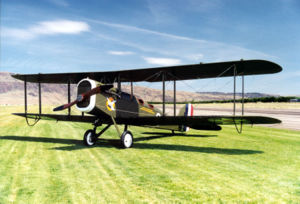Airco DH.4
| Airco DH.4 | |
|---|---|

|
|
| Type: | bomber |
| Design country: | |
| Manufacturer: | |
| First flight: |
August 1916 |
| Commissioning: |
1917 |
| Number of pieces: |
> 6,000 |
The Airco DH.4 was a single-engine, two-seat biplane that was used as a bomber in World War I. It was developed by the British company Airco . It was manufactured in the UK and as DH.4A in the USA . It was used on the British and American sides from March 1917.
The machine designed by Geoffrey de Havilland reached a peak height of over 7,000 m and a speed of 170 km / h, so that the German fighter planes had difficulties intercepting this machine. 1,880 units had been produced by the end of the war.
Civil use
The British government approved the resumption of civil aviation with effect from July 15, 1919. On the same day, England's first airline , Aircraft Transport & Travel (AT&T), carried its first paying passenger on a charter flight from London to Paris . Before it had to cease operations at the end of 1920 due to economic problems, AT&T owned two DH.4, four DH.4A, 16 DH.9 / DH.9B, eight DH.16 and three DH.18.
The DH.4 were former RAF machines, the armament of which had been removed and two passenger seats were installed in the rear cockpit . In contrast, the DH.4A was a real civilian conversion with a closed passenger cabin for two passengers behind the front cockpit.
In addition to the machines converted for AT&T, two units were also built for Handley Page Transport Ltd. for its routes to Paris and Amsterdam completed and another for Instone Air Line . This aircraft, with the G-EAMU certification, was a former RAF DH.4 and carried the Instone fleet name City of Cardiff when it began flight operations on October 12, 1919 . Sixteen months later it was converted into the DH.4A by Airco and used as the City of York between London-Croydon and Paris-Le Bourget . It was taken over by Imperial Airways in 1924 , but was no longer used there.
Military use

- Turkish Air Force
Technical data (DH.4 from 1919)
| Parameter | Data |
|---|---|
| crew | 1 |
| Passengers | 2 |
| length | 9.30 m |
| span | 12.93 m |
| height | 3.35 m |
| Takeoff weight | 1685 kg |
| Cruising speed | 195 km / h |
| Top speed | ? km / h |
| Service ceiling | 5000 m |
| Range | 485 km |
| Engines | a liquid-cooled 12-cylinder V-engine Rolls-Royce Eagle VIII with 258 kW (350 PS) |
See also
literature
- Enzo Angelucci (Ed.): World Encyclopedia of Military Aircraft. Jane's, London 1991, ISBN 0-7106-0148-4 .
- JM Bruce: The De Havilland DH4. In: Flight. October 17, 1952, pp. 506-510.
- AJ Jackson: De Havilland Aircraft since 1909. 3rd ed., Putnam, London 1987, ISBN 0-85177-802-X .
- Maurer Maurer (Ed.): The US Air Service in World War I. Volume IV Postwar Review. The Office of Air Force History Headquarters USAF, Washington 1979.
- Ray Sturtivant, Gordon Page: The DH4 / DH9 File. Air-Britain (Historians) Ltd., Kent 2000, ISBN 0-85130-274-2 .
- Owen Thetford: British Naval Aircraft since 1912. 4th ed., Putnam, London 1978, ISBN 0-370-30021-1 .
